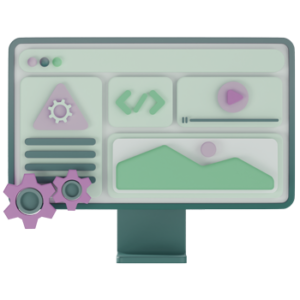As the world of digital marketing continues to evolve, so must the strategies businesses use to reach their target audiences. One area that is constantly changing is search engine optimization (SEO). What worked 6 months ago may not work today, and what works today may not work tomorrow. This is why it’s crucial for businesses that operate online to keep up with the latest SEO trends and best practices for both, on-page SEO and off-page SEO.
One of the most important angles of SEO is on-page optimization. This refers to all the factors you can control on your own website to improve your ranking on search engine results pages (SERPs). While off-page SEO factors are mostly out of your control, on-page optimization is something you can directly influence.
How does On-Page SEO help your website?
It helps search engines get a catch of what your website and its content is about.
When you optimize your web pages using relevant keywords and other elements, it signals to Google and other search engines what your page is about. This makes it easier for them to rank you for relevant searches.
It improves click-through rates from SERPs
If your listing appears higher up on a SERP, people are more likely to click through to visit our website. And if your listing includes rich snippets or other enhancements, that increases its chances of being clicked even further! Optimizing Your pages can help you earn better placement and get more clicks from searchers.
Gives users a better experience
On-page optimization isn’t just about pleasing Google – it’s also about giving users a great experience when they visit your site. Creating informative and keyword-rich titles, using easy-to-read font sizes, adding images, media, etc. All make for a better user experience. And when people have a good time on your site, they‘re more likely to come back and tell others about it.
Sets you up for success with voice search
With voice assistants like Siri, Alexa, and Google Home becoming increasingly popular, voice search is an emerging trend that businesses need to be taking advantage of now. By optimizing your site for certain keywords related to voice searches( long tail keywords ), you can make sure you show up in these search engines when people are looking for your type of business.
What is on-page SEO?
On-page SEO is the technique of optimizing your website for Google search in order to achieve higher levels of web traffic and improve your website’s visibility. The main focus of on-page SEO is to tweak your website’s design and content so that Google sees it as more relevant to what people are searching for.
There are many different factors that go into on-page SEO, but some of the most important ones include:
- Page titles and meta tags: These are key elements in your website’s code that help Google understand what your page is about. Make sure your page titles accurately reflect the topic of your page and use relevant keywords in your meta tags.
- Header tags: Header tags (H1, H2, etc.) help cut up your content into relatively smaller sections with higher readability. They also give clues to Google about what each section is about. Use keyword-rich header tags throughout your pages.
- Content: Is said to be the heavyweight between all other ranking factors when it comes to SEO – and for good reason! High-quality, well-written content will not only earn you brownie points with Google but also keep visitors engaged with your site longer (which can lead to lower bounce rates). Focus on creating helpful, informative content that uses relevant keywords throughout.
- Image optimization: Once visual files are uploaded to your website, be sure to include keywords in the name of a picture and add alt-text (a brief description of the image used by screen readers). This helps both, web users and search engines understand what’s on each image on your site
How do different on-page SEO elements work? Tips for each element

There are many different on-page SEO elements that can help you to rank higher in search engine results pages (SERPs). These include things like using the right keywords, having a good website structure, and creating compelling content. Optimizing your website for search engines can increase your chances of being found by prospective customers and drive more traffic to your site. Here are some tips on how these SEO elements work and how to optimize each one.
1. Title tags
They help search engines understand what your page is about and determine whether or not it’s relevant to a user’s query.
A good title tag should be descriptive, accurate, and include relevant keywords. It should also be easy to read and not too long. Keep in mind that title tags are just one part of on-page SEO – they’re important, but they’re not the only factor that search engines consider when ranking pages.
2. Meta descriptions
Like your title tag, your meta description should be concise, keyword-rich, and persuade searchers to click through to your website.
A meta description is a short paragraph of text that appears below a website’s URL in search engine results pages (SERPs). Meta descriptions give searchers an overview of what your page is about and why their search query is relevant. Your meta description isn’t a ranking factor on Google, but it can affect your click-through rate (CTR), a key metric for SERP success. That’s why it’s important to create an effective meta description that accurately reflects the content of your page and encourages researchers to click through to your site.
3. Headings and subheadings
Proper headings and subheadings help both users and search engines to better understand the structure of your content. Be sure to include relevant keywords in these sections as well. They help break up your content and make it easier for your readers to scan and find the information they’re looking for.
When using headings and subheadings, it is important to use them sparingly and only when they are needed. Excessive use of headings and subheadings can make your content look confusing and difficult to read.
Search engines also use titles and subtitles to understand the structure of your content and give your search rankings a boost. So if you want your content to perform well in search engines, use titles and subtitles judiciously!
4. URL structure
A well-structured URL makes it easier for users to navigate your website and find the information they’re looking for.
Useful URLs that are easy for users (and search engines) to read tend to help improve rankings. This is because they signal relevancy and authority. If you’re changing up the URL structure of an existing website, use 301 redirects to preserve link equity from the old URLs.
A good URL structure can also help improve your click-through rate (CTR) from search results. A well-optimized URL tells users what they can expect to see on the page, encouraging them to click through to your site.
There are a few things you should keep in mind when optimizing your URLs:
– Use keyword-rich words or phrases in your URLs
– Keep URLs short and easy to remember
– Use hyphens (-) to separate words in URLs
– Avoid using special characters like &, #, $, %, etc.
5.[alt text] For your images
When you are optimizing a website for on-page SEO, one of the things you need to pay attention to is alt text. This is the text that appears in case a visual can not be loaded on a page. Search engines also use it to index images.
The important thing about alt text is that it should be descriptive and keyword-rich. This way, it will help your images rank higher in search results. This will also help visitors understand what an image is about if they can’t see it.
So, make sure you take the time to add relevant and keyword-rich alt text to all of your website’s images!
6. Page loading speed
Page speed can help improve user experience as well as conversions
A faster-loading website will not only rank higher in search engine results pages (SERPs), but it will also provide a better user experience for visitors. This means that they are more likely to stay on your site, and less likely to click away if it takes too long to load.
There are a few things you can do to improve your page load speed, like optimizing images and using caching plugins. But one of the best ways is to simply use a faster host. A good web host will have servers that are optimized for speed, which can make a big difference in how quickly your pages load.
So if you’re looking to improve your on-page SEO, make sure you pay attention to your page loading speed. It’s an important factor that can help you rank higher and keep visitors happy at the same time!
7. Mobile friendliness
In order for a website to rank highly in mobile searches, it needs to have a responsive design
Mobile readiness is one of the most important factors for on-page SEO optimization. Helps search engines understand what content is relevant to mobile users and how to display it. Additionally, being mobile-friendly will improve click-through rates and organic traffic from mobile users.
8. Site architecture
Creating a logical site architecture makes it easier for both users and visitors to navigate around the site.
It helps search engines understand your website and how it is organized. A well-organized website will rank higher in search engine results pages (SERPs) than a poorly organized one.
Make sure your navigation is easy to understand and use. Use descriptive text for links so that users and search engines know where they are going. Use breadcrumbs to help users navigate back up the hierarchy if they get lost.
9. Internal linking
Linking related pages together internally helps spread link equity throughout the website
Internal linking is one of the most important on-page SEO factors. By linking to other pages on your site, you can help search engines understand your site’s structure and hierarchy and improve crawl speed. This, in turn, can help them index your pages more efficiently and rank higher in search results.
Good internal links also help users navigate your site more easily. Providing links to relevant content keeps visitors on your site longer. This makes them more likely to turn into customers or clients.
Finally, good internal links can also increase the authority of individual pages on your site. When one page links to another, it effectively attests to its quality and relevance. This helps search engines see those pages as being more trustworthy and authoritative, which can lead to higher rankings in search results
Why do online businesses need on-page SEO optimization?
There are many benefits to on-page SEO optimization, including:
• improved visibility in Google search results;
• increased web traffic levels;
• better ROI from marketing campaigns; and
• higher conversion rates.
Ultimately, on-page SEO helps online businesses to achieve their goals by improving their visibility and ranking in Google search results pages.
There are many reasons why online businesses need on-page SEO optimization. One reason is that it helps you get higher web traffic levels. Optimizing your website for Google Search increases your chances of appearing in top search results, resulting in more clicks and higher web traffic levels.
Another reason why on-page SEO optimization is important for online businesses is that it can improve your overall visibility. When your website appears in the top search results, people are more likely to notice and visit it. This increased visibility can lead to more sales and conversions for your business.
Finally, on-page SEO optimization can also help you build trust and credibility with potential customers or clients. When people see that your website appears in the top search results for their keywords or phrases, they will know that you are a credible source of information or products/services.

